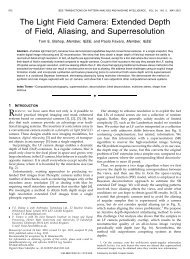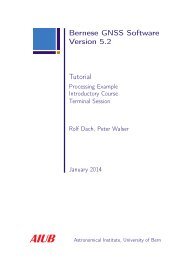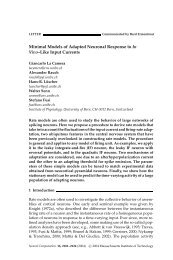Simon Peter's Mother in Law Revisited. Or Why One Should Be More
Simon Peter's Mother in Law Revisited. Or Why One Should Be More
Simon Peter's Mother in Law Revisited. Or Why One Should Be More
- No tags were found...
You also want an ePaper? Increase the reach of your titles
YUMPU automatically turns print PDFs into web optimized ePapers that Google loves.
© Smit, Peter’s <strong>Mother</strong> <strong>in</strong> <strong>Law</strong> lectio difficilior http://www.lectio.unibe.ch/03_1/smit.htm29 An extensive list can be found <strong>in</strong> Krause, ‘<strong>Mother</strong>-<strong>in</strong>-<strong>Law</strong>,’ 48, note 31.30 See also Bruce J. Mal<strong>in</strong>a, The New Testament World. Insights from Cultural Anthropology (Louisville:Westm<strong>in</strong>ster John Knox Press, 2001), 27-57, 134-160. Another view, which is based on less (and only textual)data, is presented by Ross S. Kraemer, ‘Jewish Women and Women’s Judaism(s) at the <strong>Be</strong>g<strong>in</strong>n<strong>in</strong>g ofChristianity,’ <strong>in</strong>: Ross Shepard Kraemer / Mary Rose D’Angelo, Women and Christian <strong>Or</strong>ig<strong>in</strong>s (Oxford/NewYork: Oxford University Press, 1999), 50-79. However, this valuable contribution to the discussion seems to bedeal<strong>in</strong>g with two quite privileged women, the one a land-owner the other a pr<strong>in</strong>cess. I suspect, however, thatmost women <strong>in</strong> first century Palest<strong>in</strong>e were not exactly rich land-own<strong>in</strong>g widows or successful pr<strong>in</strong>cesses whowere court<strong>in</strong>g Roman conquerors as <strong>in</strong> the case discussed by Kraemer. At least, noth<strong>in</strong>g suggests that this wasthe case with <strong>Simon</strong> Peter’s mother-<strong>in</strong>-law. In another article <strong>in</strong> the same volume Kraemer also pays attention tothe tendency to present a very gloomy picture of the position of women <strong>in</strong> first century Judaism, <strong>in</strong> order to havethe light of Christ’s liberation of them sh<strong>in</strong>e all the brighter. Accord<strong>in</strong>g to Kraemer, this view is neitherhistorically justified, nor a good safeguard aga<strong>in</strong>st anti-Judaism. Kraemer, ‘Jewish Women and Christian<strong>Or</strong>ig<strong>in</strong>s: Some Caveats’, <strong>in</strong>: Kraemer / D’Angelo, Women and Christian <strong>Or</strong>ig<strong>in</strong>s, 35-49.31 See Mal<strong>in</strong>a, New Testament World, 143ff.32 See also Sylvia Schroer, ‘Häusliche und ausserhausliche religiöse Kompetenzen israelitischer Frauen – am<strong>Be</strong>ispiel von Totenklage und Totenbefragung’, Lectio Difficilior 2002-1.(http://www.lectio.unibe.ch/02_1/schroer.htm) What she states for the Hebrew Bible seems to hold true for NewTestament times as well.33 See Krause, ‘<strong>Mother</strong>-<strong>in</strong>-<strong>Law</strong>,’ 42, note 14.34 See Mal<strong>in</strong>a, New Testament World, 33ff.35 See Mal<strong>in</strong>a, New Testament World, 43ff.36 See Mal<strong>in</strong>a, New Testament World, 47ff. In these respects Jesus is <strong>in</strong>deed revolutionary, although the result ofhis actions seems to rema<strong>in</strong> with<strong>in</strong> the social boundaries. Historically speak<strong>in</strong>g, one should also ask if it is fair toexpect another outcome, which does not mean that this story could be used as a legitimisation for keep<strong>in</strong>g peoplesuccessfully unhappy (or happy) with<strong>in</strong> a given system. In other words, one should not read the story asencourag<strong>in</strong>g a Gospel that tells the oppressed to ‘just serve us as <strong>Simon</strong> Peter’s mother-<strong>in</strong>-law did, because thatis what the Gospel tells you to do.’37 Apart from the article mentioned earlier see also Monika Fander, Die Stellung der Frau im Markusevangelium(Münsteraner Theologische Abhandlungen 8; Altenberge: Telos-Verlag, 1989), 17-25.38 Fander, ‘Frauen’, 413f.39 Fander, Stellung, 21 suggests that the au)toi=j <strong>in</strong> Mark 1:31 should have been au)tw?~ <strong>in</strong> the Vorlage, butarguments are lack<strong>in</strong>g here, only Matthew 8:15 actually has au)tw?~ but the text -critical situation is less ideal <strong>in</strong>Mark 1:31 and <strong>in</strong> Luke 4:39 noth<strong>in</strong>g can be deduced from this, apart from a ‘christologisation’ of the story <strong>in</strong>Matthew.40 Mary Rose D’Angelo, ‘(Re)presentations of Women <strong>in</strong> the Gospels: John and Mark’ <strong>in</strong>: Ross ShepardKraemer / Mary Rose D’Angelo (eds.), Women & Christian <strong>Or</strong>ig<strong>in</strong>s, 129-159, 139.41 Kraemer / D’Angelo, Women & Christian <strong>Or</strong>ig<strong>in</strong>s, 139.42 See also Esther A. de Boer, The Gospel of Mary. <strong>Be</strong>yond a Gnostic and a Biblical Mary Magdalene(Proefschrift Theologische Universiteit van de Gereformeerde Kerken <strong>in</strong> Nederland te Kampen, 3-12-2002),11
















